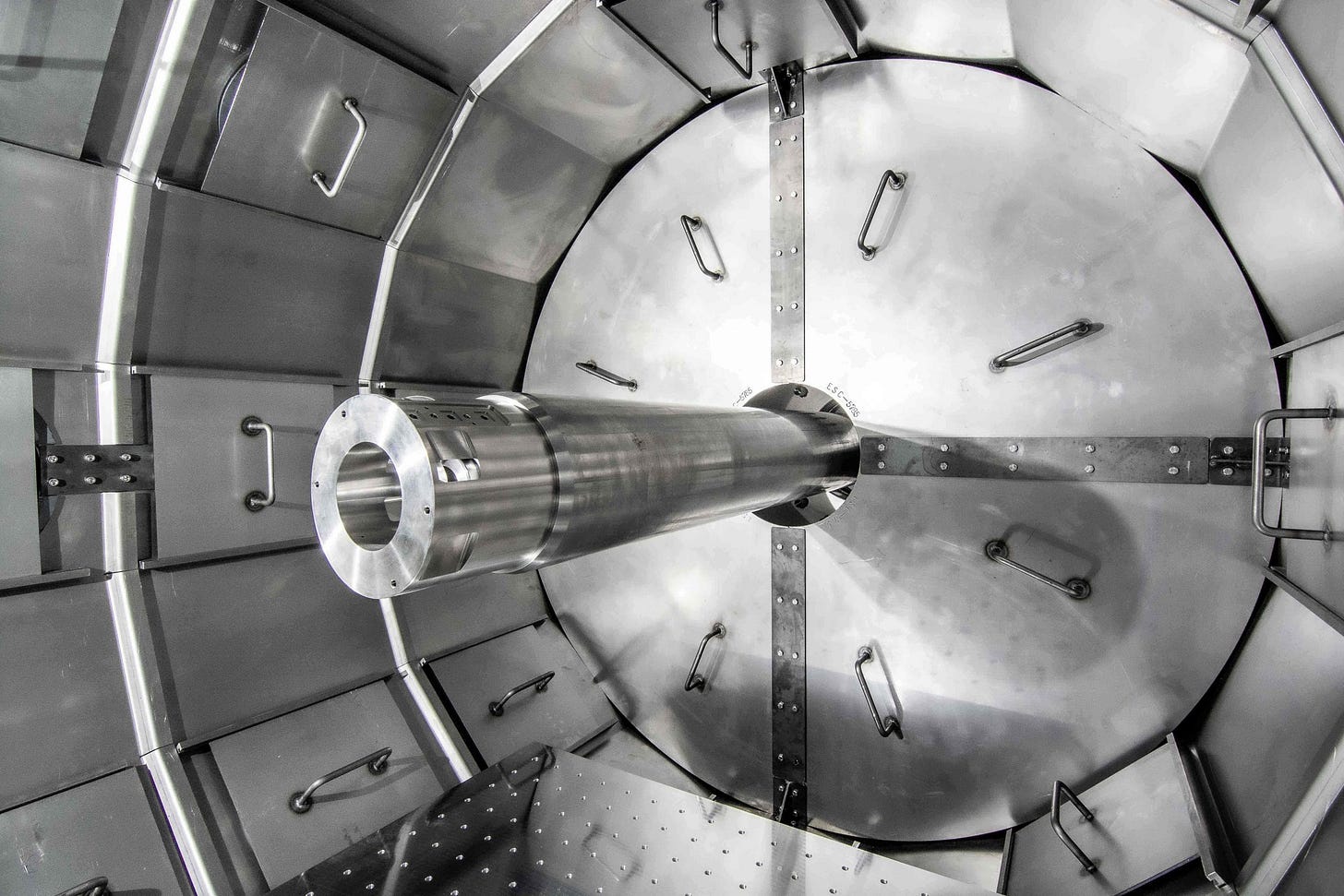🌕Startup Moon Landing; ⚛️ Simplified Stellarator;🛡️Defense Unicorns Soar; 🧬 First Bio-Computer; 🌋 Chris Wright Geothermal Endorsement & more | Deep Tech Briefing #51
Weekly Intelligence on Deep Tech Startup and Venture Capital.
Thanks for reading Deep Tech Briefing, our weekly intelligence on deep tech startups and venture capital. Every Sunday, we curate and analyze the most relevant startup advancements, VC trends, and industry shifts you need to know—if you want to lead!
To enjoy the full experience, become a Premium Member! The Scenarionist Premium is designed to make you a better Deep Tech Founder, Investor, and Operator. Invest in yourself, and upgrade today!
Dear Friends,
This week, the Moon is no longer the exclusive domain of superpowers. The latest lunar landing signals something bigger: a shift from government-led space programs to commercial execution, where agility and capital efficiency will determine the winners of this new era. The question is no longer if private companies can land on the Moon, but how quickly they can scale operations and turn lunar exploration into a viable business.
But this isn’t just about space. Across deep tech, capital is chasing execution, not speculation. In aerospace, new partnerships are reshaping orbital logistics, paving the way for the next generation of reusable space platforms. Meanwhile, stealth-mode startups are rethinking aviation itself, exploring nuclear-powered propulsion that could redefine endurance and operational efficiency in both commercial and defense sectors.
The fusion sector is also undergoing a strategic recalibration, with companies pivoting from long-term power plant development to near-term monetization strategies. Licensing high-energy plasma technologies to adjacent industries, from defense to materials testing, is becoming a pragmatic path to revenue—potentially accelerating fusion’s commercial timeline.
Elsewhere, deep tech’s momentum is translating into record valuations. A defense startup has surpassed $5 billion, underscoring the market’s appetite for autonomous military technologies. At the intersection of biotech and computing, the first commercial biological computer has been unveiled, blending lab-grown neurons with silicon to enable low-power, adaptive intelligence—an early glimpse of what could become a radical shift in computing architectures.
Materials science is quietly undergoing its own transformation. A university spin-off is pushing the boundaries of nanostructured metals to enhance battery performance and hydrogen storage, reinforcing the critical role of advanced materials in enabling next-gen energy solutions.
From lunar landings to AI-driven defense, nuclear aviation to biological computing, this week’s briefing captures the pulse of deep tech’s rapid evolution. As funding tightens in some sectors, capital is flowing into technologies that can deliver real-world impact—and the companies that execute with precision will define the next decade.
This is just a preview. For the full breakdown, exclusive insights, and analysis of what comes next, dive into the full briefing.
Enjoy the read!
✨ For more, see Membership | Partnership | Deep Tech Catalyst
Interesting Reading:
If you’re hungry for more context, here are a few curated links:
The Unicorn Boom is Over: Why Startups Must Pivot to Culture to Survive – As sky-high valuations fade, founders must rethink their approach to building resilient companies. Medium.
Why Varda is developing cancer drugs in space – The startup is betting on microgravity to enable breakthroughs in drug development. Yahoo Finance.
The Humanoid 100 – Mapping the Humanoid Robot Value Chain – A deep dive into the emerging ecosystem of humanoid robotics and its commercial potential. Morgan Stanley Research.
Eric Schmidt argues against a ‘Manhattan Project’ for AGI – The former Google CEO weighs in on AI governance and the risks of a top-down, government-led initiative. TechCrunch.
General Catalyst loses three top investors as the firm expands beyond venture, contemplates IPO – A leading VC firm faces internal shifts as it explores new frontiers. TechCrunch.
Inside the mind-bending, tin-blasting, and hyper-political world of microchips – A look into the geopolitical and technological battles shaping the future of semiconductors. The Guardian.
LPs are focused on building relationships – Investors are prioritizing long-term partnerships over transactional funding in today’s venture landscape. Venture Capital Journal.
Climate VCs are raising their second funds – With market realities shifting, sustainability investors face new challenges. Sifted.
Funding to women-founded startups declined 12% in 2024 – but that wasn’t far behind the broader market – A nuanced look at gender disparities in venture capital. TechCrunch.
The Big Idea:
The Moon Opens to Venture-Backed Startups: Firefly Aerospace’s Historic Blue Ghost Landing
Space exploration has long been dominated by governmental agencies, with NASA, Roscosmos, CNSA, and ESA leading the charge. However, the recent success of Firefly Aerospace’s Blue Ghost lander marks a significant shift: the increasing capability of private companies to execute complex space missions. This event is not just a technological milestone but a critical indicator of the evolving economics and competitive landscape of lunar exploration.
Firefly’s Blue Ghost successfully landed on the Moon’s surface in an upright, stable position—an achievement that even some governmental missions have struggled with. This marks the second-ever private lunar landing, following Intuitive Machines’ Odysseus lander in early 2024, which tipped over upon touchdown. Firefly's lander carried ten NASA payloads as part of the Commercial Lunar Payload Services (CLPS) initiative, a program that seeks to create a sustainable commercial space industry. For NASA, the $140 million contract with Firefly is an experiment in outsourcing lunar operations to the private sector. If successful, this model could reduce costs for future missions, shift financial risk to private companies, and accelerate the timeline of lunar exploration.
The implications of this landing are far-reaching. First, it demonstrates that small, venture-backed space startups can deliver results on par with, or even exceeding, governmental programs. The precision landing of Blue Ghost within 100 meters of its target suggests that commercial companies are refining critical landing technologies. This has major ramifications for the upcoming Artemis program, which aims to return humans to the Moon in 2027. If NASA can reliably depend on private firms for lunar payload deliveries, it could enable a steady cadence of robotic missions that lay the groundwork for human settlement.
Second, this success intensifies competition among private lunar exploration firms. Firefly now directly challenges Intuitive Machines and Astrobotic, both of which have CLPS contracts. While Firefly's lander performed flawlessly, Intuitive Machines’ Odysseus had technical difficulties, including a tipped-over landing that partially impaired its operations. This performance gap could influence future NASA contracts. Meanwhile, Blue Origin, another key player in the lunar economy, is developing human-rated lunar landers, while ispace (a Japanese firm) is continuing its robotic missions. The commercial lunar sector is now a race to prove reliability and cost-effectiveness.
However, challenges remain. Lunar operations are notoriously difficult, as evidenced by previous failed landings from both governmental and private missions. Even for Blue Ghost, success is not guaranteed beyond the landing; its mission duration is limited to 14 days before the frigid lunar night disables operations. Furthermore, commercializing the Moon still lacks a clear revenue model beyond government contracts. While future prospects, such as lunar mining and in-situ resource utilization, are being explored, they are not yet viable business cases.
That said, this landing represents a paradigm shift. The Moon, once the exclusive domain of superpowers, is now accessible to venture-backed startups. The question is no longer whether private companies can land on the Moon—it’s how quickly and cost-effectively they can scale operations. The real test will be whether these firms can create sustainable business models beyond government contracts, positioning themselves as indispensable partners in the next phase of lunar exploration.
Quick Dives:
🔸 First Light Fusion Shifts Strategy to accelerate commercial fusion
The fusion industry is witnessing an influx of private capital, with over $7.1 billion invested globally in the past few years. Yet, commercialization remains elusive, with many firms facing extended development timelines and steep capital costs. Recognizing these challenges, First Light Fusion has announced a strategic pivot: rather than developing its own power plant, it will focus on licensing its amplifier technology to other fusion developers.
First Light's projectile-based inertial fusion approach has demonstrated record-breaking pressure amplification, proving effective in tests at Sandia National Laboratories’ Z Machine. By integrating its amplifiers into various inertial fusion systems, including laser-driven reactors, the company positions itself as a key supplier of fusion-enabling technology.
This shift allows First Light to generate near-term revenue, significantly reducing its reliance on long-term funding rounds. The company is also expanding into non-fusion sectors, partnering with NASA and aerospace institutions to apply its amplifiers in extreme pressure testing for materials used in space exploration and defense systems.
The move mirrors a broader trend where fusion startups monetize their technical breakthroughs in material science, plasma physics, and high-energy systems before achieving grid-scale power generation.
🔸ElevationSpace and Isar Aerospace Partner for 2026 Space Logistics Mission
As the global space economy accelerates, Japanese startup ElevationSpace has secured a 2026 launch contract with Isar Aerospace, marking a key milestone for both companies in expanding commercial in-space logistics.






